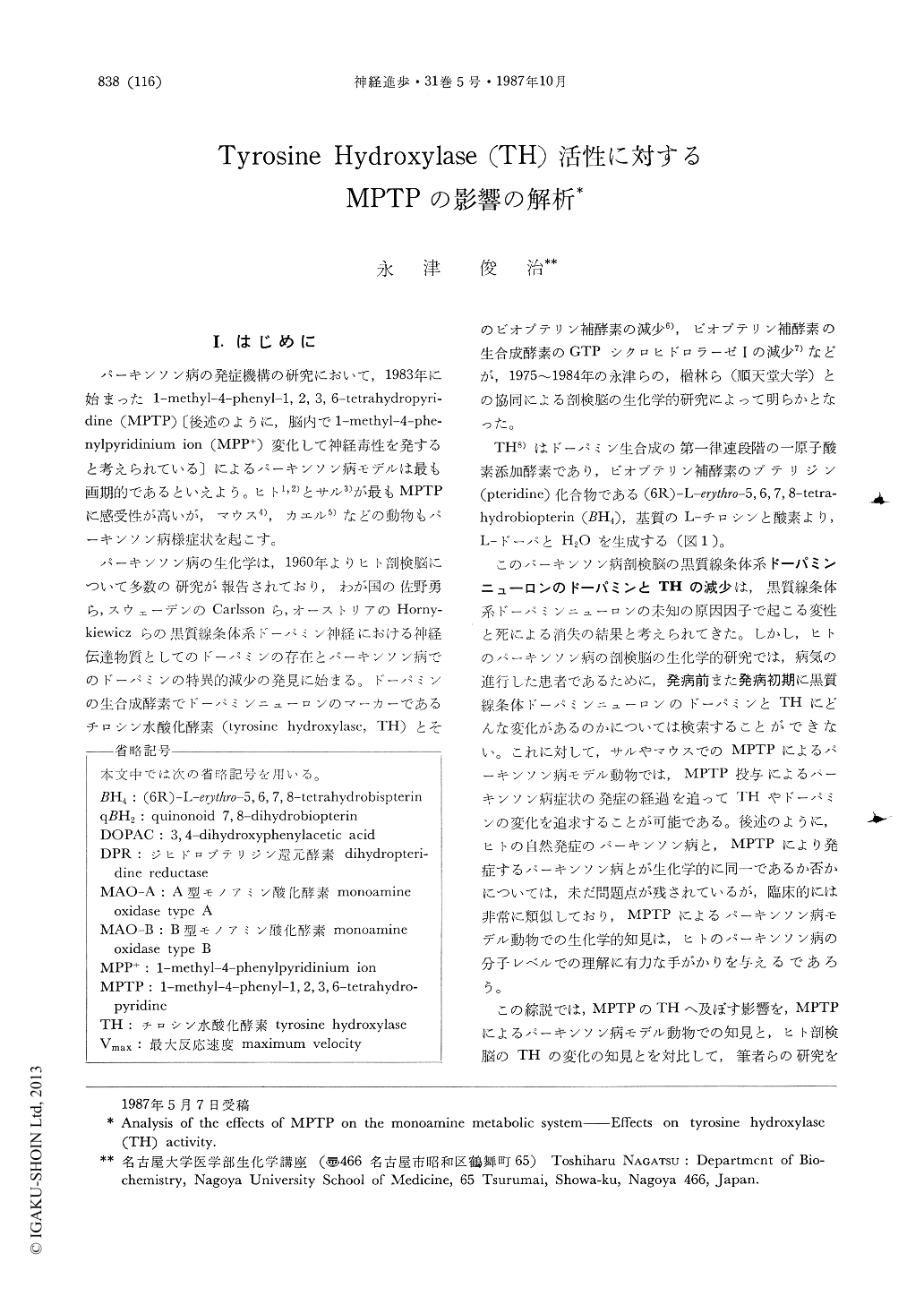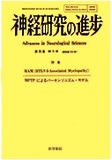Japanese
English
- 有料閲覧
- Abstract 文献概要
- 1ページ目 Look Inside
I.はじめに
パーキンソン病の発症機構の研究において,1983年に始まった1-methyl-4-phenyl-1,2,3,6-tetrahydropyridine(MPTP)〔後述のように,脳内で1-methyl-4-phe-nylpyridinium ion(MPP+)変化して神経毒性を発すると考えられている〕によるパーキンソン病モデルは最も画期的であるといえよう。ヒト1,2)とサル3)が最もMPTPに感受性が高いが,マウス4),カエル5)などの動物もパーキンソン病様症状を起こす。
パーキンソン病の生化学は,1960年よりヒト剖検脳について多数の研究が報告されており,わが国の佐野勇ら,スウェーデンのCarlssonら,ナーストリアのHornykiewiczらの黒質線条体系ドーパミン神経における神経伝達物質としてのドーパミンの存在とパーキンソン病でのドーパミンの特異的減少の発見に始まる。ドーパミンの生合成酵素でドーパミンニューロンのマーカーであるチロシン水酸化酵素(tyrosine hydroxylase,TH)とそのビオプテリン補酵素の減少6),ビオプテリン補酵素の生合成酵素のGTPシクロヒドロラーゼIの減少7)などが,1975〜1984年の永津らの,楢林ら(順天堂大学)との協同による剖検脳の生化学的研究によって明らかとなった。
Tyrosine hydroxylase (TH) activity in vitro (Vmax) was reduced in the striatum and substantia nigra from the patients with Parkinson's disease to approximately 10% of that from the control patients. TH reduction only in the striatum, but not in the substantia nigra, was found in a case of juvenile Parkinson's disease. The acute administration of MPTP (30 mg/kg, s.c., 1 h prior to sacrifice) in mice resulted in a decrease of tyrosine hydroxylation in situ in tissue slices but not in vitro in homogenates. In contrast, repeated injection of MPTP (30 mg/kg s.c. daily for 8 days) caused a decrease of TH activity both in vitro in homogenate and in situ in tissue slices, and the decrease of TH protein in the striatum was also confirmed by enzyme immunoassay of TH protein and by immunohistochemistry of TH. The late reduction in TH activity and protein by repeated treatment of mice with MPTP may be caused by the loss of the nerve terminals of the nigrostriatal dopaminergic neu-rons. The acute inhibition of the TH system in situ in tissue slices by MPTP was found to be prevented by a monoamine oxidase inhibitor and by a dopamine uptake inhibitor, but that by MPP+ was not prevented by a monoamine oxidase inhibitor and was prevented only by a dopamine uptake inhibitor. The inhibition of the TH system by MPP+ analogues was applied for the screening of nigrostriatal dopaminergic neurotoxins. As a result, tetrahydroisoquinoline-related compounds were thought to be such neurotoxin candidates. Tetrahydroisoquinoline had a slight but significant effect on the reduction TH in the striatum of mice after repeated injection. Tetrahydroisoquinoline and 2-methyl-tetrahydroquinoline were identified in the human brain for the first time from parkinsonian patients and normal controls. The concentration of 2-methyl-tetrahydroquinoline was similar between parkinsonian and control brains, whereas the concentration of tetrahydroisoquinoline was markedly higher in the parkinsonian brain than in the normal brain.

Copyright © 1987, Igaku-Shoin Ltd. All rights reserved.


